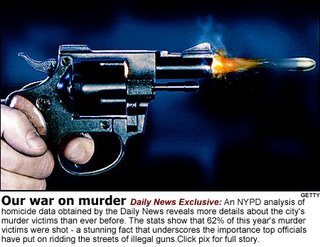
So it's up to us to sort them out, 'k?
"A sophisticated NYPD analysis of homicide data obtained by the Daily News reveals more details about the city's murder victims than ever before.
The police statistics show that 62% of this year's murder victims were shot - a stunning fact that underscores the importance Mayor Bloomberg and Police Commissioner Raymond Kelly have put on ridding the streets of illegal guns.
"It's an absolute priority," Kelly told The News during an exclusive interview.
The NYPD's murder analysis shows cops are tracking not only how people are killed, but every available piece of information on each homicide.
"We started this about two years ago," Kelly said. "We know the method, motive, relationship, location, time and additional factors."
Kelly said investigators use the data to spot patterns in drug-related, gang-related and club-related crime. Cops also look for trends in murders tied to race or ethnicity.
"We want to fine tune the information," Kelly said. "The more specificity we can get, the better the potential that we have to prevent a crime of violence."
According to the NYPD homicide database:
The data have already led to changes in the department's patrol patterns and altered decisions on officer deployment in some precincts. In other precincts, the data has given cops a guide to areas prone to violence.
Armed with the information, cops plan to put surveillance cameras in 500 hot spots throughout the city, with about 130 cameras already in place.
Police also have used portable cameras in high-crime areas to provide direct video feeds to housing or precinct cops. "We've gotten good feedback from residents," Kelly said.
Serious crime - including murders, rapes, robberies and felony assaults - has fallen 4.6% citywide this year, but the murder rate has climbed 6.8%, compared with the same period in 2005.
Police officials said the increase in murders was caused in part by an unusually high number of "reclassified homicides."
Reclassified homicides refers to recent deaths blamed on past, sometimes decades-old, wounds inflicted by attacks.
So far this year, the medical examiner has ruled that 31 people died recently from past injuries. In past years, the city averaged about 12, police said.
Still, some areas of the city have become more violent this year. The number of murders has more than doubled, rising to 19 from nine, in the 77th Precinct, which covers northern Crown Heights and Prospect Heights in Brooklyn.
"You might be going somewhere and the bullets might start flying," said Lynessa Adonis, 30, a mom who lives in Crown Heights, a few blocks from where the body of 16-year-old Chanel Petro-Nixon was found in June.
Chanel was last seen alive about 6 p.m. on Sunday, June 18 - Father's Day. She left her home to fill out a job application at a nearby Applebee's restaurant. Four days later, her strangled body was found in a trash bag on Kingston Ave. No arrests have been made.
"I don't want my kids living without a mother," Adonis said.
Despite the rise in slayings, police officials noted that the city is on pace to have the second-lowest number of murders since the early 1960s. The record-low was set last year when there were 539 homicides.
"One homicide is too many," Kelly said, before noting that the murder tally has been below 600 each year that Bloomberg has been mayor. "That didn't happen in the previous administration."
Extra points if you can identify the cheap ass revolver in the picture. But we won't say a damned thing about the bad trigger finger.
Quick note on "Reclassified Homicides". Someone shoots you in the foot in 1960. You die of lung cancer in 2006. You are a homicide.
No comments:
Post a Comment